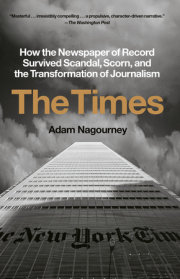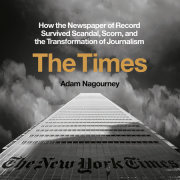Chapter 1
A Man of His Times
It was December 17, 1976, a cool and cloudy day in New York. Jimmy Carter would be sworn in as the thirty-ninth president in just over a month. There were threats of a destabilizing oil-price war in the Middle East. The nation was emerging from a three-year economic downturn that had been particularly debilitating for New York City, which was struggling through its own financial crisis, as employees of
The New York Times were reminded when they walked to work through Times Square, with its boarded-up stores, pornographic movie theaters, and street-corner drug dealers. A revival of Fiddler on the Roof, directed by Jerome Robbins and with Zero Mostel reprising his role as Tevye, was about to open at the Winter Garden Theatre. Rupert Murdoch had just purchased the
New York Post, and the newsstands offered a morning tabloid splash of headlines about crime, sex, and the fiscal crisis, including the latest cuts in subway and bus service. This was the season of the Son of Sam shootings, and New York was on high alert.
On this day, A. M. Rosenthal wrote a note to his staff about his future, and the future of his newspaper. It was slipped into mailboxes and posted on bulletin boards in the fifteen-story building off Times Square that had been the headquarters of
The New York Times since 1913. Abe Rosenthal, as he was known, was fifty-four years old and had joined the
Times in 1943 as its campus correspondent at City College of New York. He had covered the United Nations, Japan, India, and Poland, where he won the Pulitzer Prize for his “perceptive and authoritative” coverage of the Communist regime. He had been a metropolitan editor, associate managing editor, assistant managing editor, and managing editor. No one defined
The New York Times—and by virtue of that, American journalism—as much as Rosenthal. A package of brilliance and insecurities, a remarkable foreign correspondent and editor, he paraded both his love of journalism and his contempt for reporters and editors he considered mediocre or politically suspect. His
Times was read by presidents, cabinet secretaries, mayors, foreign leaders, members of Congress, Hollywood directors and theater producers, university presidents, scholars, publishers, business executives, television news executives, and rival editors.
You have to understand this, Rosenthal once said to a young reporter in his office, his vibrating, nasal voice resonant of his years growing up in the Bronx. When an educated, important person anywhere in America runs into another educated, important person anywhere in America, each will have assumed of the other that they have read
The New York Times.
Rosenthal held the newspaper in the highest regard. “I do believe this would be a lesser country without
The New York Times,” he said in an oral history in 1986. And he held himself in just as high regard. “I’m a very good editor,” he once said. “I know that. And that’s putting it mildly.” Few would dispute either of those assertions. Rosenthal took over the newsroom in 1969, after James B. Reston, the paper’s chief Washington columnist, served a brief and unsuccessful turn as executive editor. Reston would not give up his column or his home in Washington, making a weekly commute to New York, and those distractions were reflected in his performance. “A disaster,” Arthur Ochs Sulzberger, Sr., the publisher, later said of Reston’s time as executive editor. But Punch Sulzberger was loyal to Reston, a family friend and himself an institution in journalism of the 1950s and ’60s, and, with due deference, said the appointment was always meant to be temporary as he sent Reston back to Washington. Sulzberger retired the title of executive editor and asked Rosenthal, a deputy to Reston, to settle for the lesser title of managing editor, but with all the responsibilities and authority Reston had as executive editor.
No one was surprised when Sulzberger, resurrecting the title seven years later, and broadening its responsibilities to include what had been the separate Sunday newspaper, awarded it to Rosenthal, choosing him over another former foreign correspondent and editor, Max Frankel, who had run the Sunday newspaper. Frankel would become the editorial page editor. Sulzberger left it to Rosenthal to make the announcement, and that was the purpose of the memo he distributed that December day.
The Publisher will announce today the following promotions and additions in the top news group of the paper effective January 1. I will become executive editor.
Happy holidays to all!
Even at this high point in a career filled with high points, and with more to come, Rosenthal was difficult and disconsolate, the way he had always been and would always be. “I am quite unhappy about some things I have been seeing in the paper, not seeing, or seeing too late,” he wrote his editors a few weeks before his appointment, distressed that Newsweek had obtained the first interview with Cyrus Vance, the incoming secretary of state. Rosenthal realized the
Times would come in second from time to time, he said, “but, believe me, I know the difference between that and a lumpish rhythm.” Yet for all his unhappiness, the newspaper, after suffering through an economic downturn, was rounding a corner. Rosenthal’s command over the
Times had never been as sweeping as it was this December, and the world of journalism celebrated his promotion. welcome to the kingdom and power of executive editordom, whatever it may be, Ben Bradlee, the executive editor of
The Washington Post, wrote him in a telegraph, drawing on the title of Gay Talese’s book on the
Times, published in 1969: The Kingdom and the Power.
Frankel and Rosenthal were rivals, all the more so after this appointment, but that was papered over for this moment. “Abe: By any other name, you still lead a great crew,” Frankel said in a hand-written note.
“Titles, schmitles!” Rosenthal responded on Christmas Eve. “It’s all a lot of fun! Thank you for that sweet note.” His note, addressed to “Mr. Frankel,” was typed.
Sulzberger would remain loyal to Abe Rosenthal for another nine years, dazzled by his talent, their partnership, and the quality of the newspaper published day after day on his watch. Rosenthal had helped establish
The New York Times as a prosperous business, and more importantly, as a model of daily journalism. But gradually, his eccentricities, excesses, and abuses would become impossible to ignore.
***
At the end of 1962, Turner Catledge, the paper’s managing editor, flew to Tokyo to meet with Rosenthal, who was then the paper’s correspondent there. Are you happy here, Abe? Catledge asked as they traveled around Japan. Catledge really wasn’t looking for an answer; his decision was made. He wanted Rosenthal to return to New York to run the city desk. Rosenthal left reporting for editing and proceeded to reinvigorate what was probably the weakest and most neglected news desk at the
Times. “This is the candor department?” Rosenthal responded when asked years later to describe his first impressions of the city desk, which would later be known as the metropolitan desk. “I was stunned and shocked, frankly.” He described a dispirited, indolent staff producing unpublishable copy. Rosenthal seized Catledge’s mandate to transform the metropolitan New York coverage, pruning the old-timers who would disappear for long lunches or drop their heads down when the editors were looking for a reporter to dispatch on a story. He had no patience for the tradition of valuing seniority over talent and energy. He had fresh ideas about what made a story for the
Times—for instance, a long article exploring the increased visibility of homosexuals on the streets of New York, which he had noticed upon his return from overseas.
The Times would be bolder covering its own backyard, never an easy matter for a New York–based newspaper that viewed its primary mission as chronicling Washington and the world.
Rosenthal pushed his staff hard, and he played favorites, and before long, he would glance up from his desk, which he had turned around so his back was no longer facing the rows of reporters, survey the newsroom that stretched nearly a block before him, with the coffee-stained carpets and drab metal desks under a haze of cigarette smoke, and realize that his reporters did not like him. And he would begin asking his editors a question that he would pose repeatedly over the years: Why do they hate me? It was a melancholy and no doubt manipulative query that often came after he’d had a few glasses of wine. He would try to win them over, popping by in the evenings to join reporters for drinks at Sardi’s on West Forty-fourth Street. But Rosenthal could not hold his liquor. He would talk too openly about reporters and his own editors who were not at the table and awake the next morning in a cloud of regret about his indiscretions.
Copyright © 2023 by Adam Nagourney. All rights reserved. No part of this excerpt may be reproduced or reprinted without permission in writing from the publisher.






